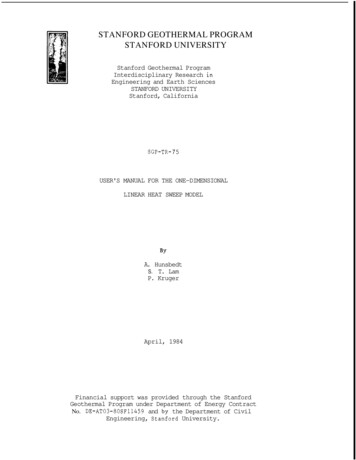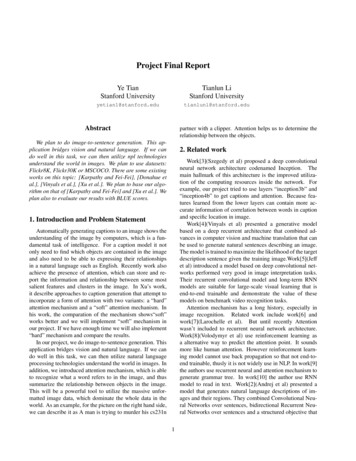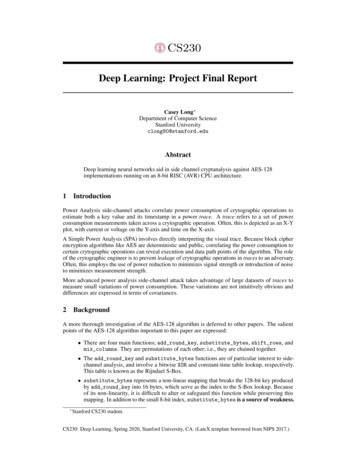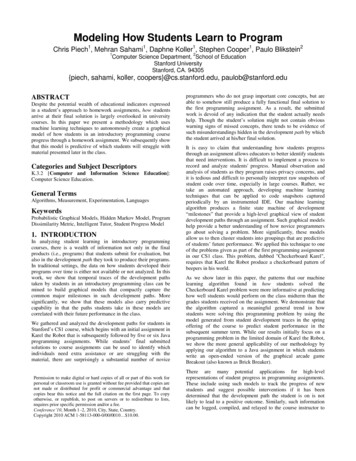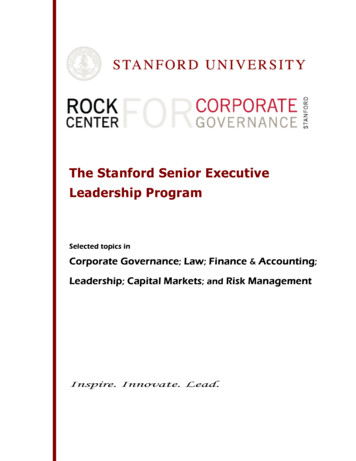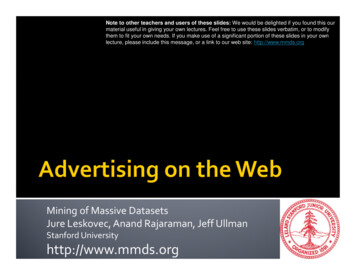
Transcription
Note to other teachers and users of these slides: We would be delighted if you found this ourmaterial useful in giving your own lectures. Feel free to use these slides verbatim, or to modifythem to fit your own needs. If you make use of a significant portion of these slides in your ownlecture, please include this message, or a link to our web site: http://www.mmds.orgMining of Massive DatasetsJure Leskovec, Anand Rajaraman, Jeff UllmanStanford Universityhttp://www.mmds.org
Classic model of algorithms You get to see the entire input, then computesome function of it In this context, “offline algorithm” Online Algorithms You get to see the input one piece at a time, andneed to make irrevocable decisions along the way Similar to the data stream modelJ. Leskovec, A. Rajaraman, J. Ullman: Mining of Massive Datasets, http://www.mmds.org2
Boys1a2b3c4dGirlsNodes: Boys and Girls; Edges: PreferencesGoal: Match boys to girls so that maximumnumber of preferences is satisfiedJ. Leskovec, A. Rajaraman, J. Ullman: Mining of Massive Datasets, http://www.mmds.org4
Boys1a2b3c4dGirlsM {(1,a),(2,b),(3,d)} is a matchingCardinality of matching M 3J. Leskovec, A. Rajaraman, J. Ullman: Mining of Massive Datasets, http://www.mmds.org5
Boys1a2b3c4dGirlsM {(1,c),(2,b),(3,d),(4,a)} is aperfect matchingPerfect matching all vertices of the graph are matchedMaximum matching a matching that contains the largest possible number of matchesJ. Leskovec, A. Rajaraman, J. Ullman: Mining of Massive Datasets, http://www.mmds.org6
Problem: Find a maximum matching for agiven bipartite graph A perfect one if it exists There is a polynomial-time offline algorithmbased on augmenting paths (Hopcroft & Karp 1973,see http://en.wikipedia.org/wiki/Hopcroft-Karp algorithm) But what if we do not know the entiregraph upfront?J. Leskovec, A. Rajaraman, J. Ullman: Mining of Massive Datasets, http://www.mmds.org7
Initially, we are given the set boysIn each round, one girl’s choices are revealed That is, girl’s edges are revealed At that time, we have to decide to either: Pair the girl with a boy Do not pair the girl with any boy Example of application:Assigning tasks to serversJ. Leskovec, A. Rajaraman, J. Ullman: Mining of Massive Datasets, http://www.mmds.org8
1a2b3c4d(1,a)(2,b)(3,d)J. Leskovec, A. Rajaraman, J. Ullman: Mining of Massive Datasets, http://www.mmds.org9
Greedy algorithm for the online graphmatching problem: Pair the new girl with any eligible boy If there is none, do not pair girl How good is the algorithm?J. Leskovec, A. Rajaraman, J. Ullman: Mining of Massive Datasets, http://www.mmds.org10
For input I, suppose greedy producesmatching Mgreedy while an optimalmatching is MoptCompetitive ratio minall possible inputs I ( Mgreedy / Mopt )(what is greedy’s worst performance over all possible inputs I)J. Leskovec, A. Rajaraman, J. Ullman: Mining of Massive Datasets, http://www.mmds.org11
Consider a case: Mgreedy MoptConsider the set G of girlsmatched in Mopt but not in MgreedyThen every boy B adjacent to girlsin G is already matched in Mgreedy:Mopt1a2b3c4dB {}G { If there would exist such non-matched(by Mgreedy) boy adjacent to a non-matchedgirl then greedy would have matched them Since boys B are already matched in Mgreedy then(1) Mgreedy B J. Leskovec, A. Rajaraman, J. Ullman: Mining of Massive Datasets, http://www.mmds.org12}
Summary so far:1Mopta Girls G matched in Mopt but not in Mgreedy23 (1) Mgreedy B bcd4There are at least G such boysG { }B {}( G B ) otherwise the optimalalgorithm couldn’t have matched all girls in G So: G B Mgreedy By definition of G also: Mopt Mgreedy G Worst case is when G B Mgreedy Mopt 2 Mgreedy then Mgreedy / Mopt 1/2J. Leskovec, A. Rajaraman, J. Ullman: Mining of Massive Datasets, http://www.mmds.org13
1a2b3c4d(1,a)(2,b)J. Leskovec, A. Rajaraman, J. Ullman: Mining of Massive Datasets, http://www.mmds.org14
Banner ads (1995-2001) Initial form of web advertising Popular websites chargedX for every 1,000“impressions” of the ad Called “CPM” rate(Cost per thousand impressions) Modeled similar to TV, magazine adsCPM cost per milleMille thousand in Latin From untargeted to demographically targeted Low click-through rates Low ROI for advertisersJ. Leskovec, A. Rajaraman, J. Ullman: Mining of Massive Datasets, http://www.mmds.org16
Introduced by Overture around 2000 Advertisers bid on search keywords When someone searches for that keyword, thehighest bidder’s ad is shown Advertiser is charged only if the ad is clicked on Similar model adopted by Google with somechanges around 2002 Called AdwordsJ. Leskovec, A. Rajaraman, J. Ullman: Mining of Massive Datasets, http://www.mmds.org17
J. Leskovec, A. Rajaraman, J. Ullman: Mining of Massive Datasets, http://www.mmds.org18
Performance-based advertising works! Multi-billion-dollar industry Interesting problem:What ads to show for a given query? (Today’s lecture) If I am an advertiser, which search termsshould I bid on and how much should I bid? (Not focus of today’s lecture)J. Leskovec, A. Rajaraman, J. Ullman: Mining of Massive Datasets, http://www.mmds.org19
Given: 1. A set of bids by advertisers for search queries2. A click-through rate for each advertiser-query pair3. A budget for each advertiser (say for 1 month)4. A limit on the number of ads to be displayed witheach search queryRespond to each search query with a set ofadvertisers such that: 1. The size of the set is no larger than the limit on thenumber of ads per query 2. Each advertiser has bid on the search query 3. Each advertiser has enough budget left to pay forthe ad if it is clicked uponJ. Leskovec, A. Rajaraman, J. Ullman: Mining of Massive Datasets, http://www.mmds.org20
A stream of queries arrives at the searchengine: q1, q2, Several advertisers bid on each queryWhen query qi arrives, search engine mustpick a subset of advertisers whose ads areshown Goal: Maximize search engine’s revenues Simple solution: Instead of raw bids, use the“expected revenue per click” (i.e., Bid*CTR) Clearly we need an online algorithm!J. Leskovec, A. Rajaraman, J. Ullman: Mining of Massive Datasets, http://www.mmds.org21
AdvertiserBidCTRBid * CTRA 1.001%1 centB 0.752%1.5 centsC 0.502.5%1.125 centsClick throughrateJ. Leskovec, A. Rajaraman, J. Ullman: Mining of Massive Datasets, http://www.mmds.orgExpectedrevenue22
AdvertiserBidCTRBid * CTRB 0.752%1.5 centsC 0.502.5%1.125 centsA 1.001%1 centJ. Leskovec, A. Rajaraman, J. Ullman: Mining of Massive Datasets, http://www.mmds.org23
Two complications: Budget CTR of an ad is unknown Each advertiser has a limited budget Search engine guarantees that the advertiserwill not be charged more than their daily budgetJ. Leskovec, A. Rajaraman, J. Ullman: Mining of Massive Datasets, http://www.mmds.org24
CTR: Each ad has a different likelihood ofbeing clicked Advertiser 1 bids 2, click probability 0.1 Advertiser 2 bids 1, click probability 0.5 Clickthrough rate (CTR) is measured historically Very hard problem: Exploration vs. exploitationExploit: Should we keep showing an ad for which we havegood estimates of click-through rateorExplore: Shall we show a brand new ad to get a bettersense of its click-through rateJ. Leskovec, A. Rajaraman, J. Ullman: Mining of Massive Datasets, http://www.mmds.org25
Our setting: Simplified environment There is 1 ad shown for each queryAll advertisers have the same budget BAll ads are equally likely to be clickedValue of each ad is the same ( 1)Simplest algorithm is greedy: For a query pick any advertiser who hasbid 1 for that query Competitive ratio of greedy is 1/2J. Leskovec, A. Rajaraman, J. Ullman: Mining of Massive Datasets, http://www.mmds.org26
Two advertisers A and B A bids on query x, B bids on x and y Both have budgets of 4 Query stream: x x x x y y y y Worst case greedy choice: B B B B Optimal: A A A A B B B B Competitive ratio ½ This is the worst case! Note: Greedy algorithm is deterministic – it alwaysresolves draws in the same wayJ. Leskovec, A. Rajaraman, J. Ullman: Mining of Massive Datasets, http://www.mmds.org27
BALANCE Algorithm by Mehta, Saberi,Vazirani, and Vazirani For each query, pick the advertiser with thelargest unspent budget Break ties arbitrarily (but in a deterministic way)J. Leskovec, A. Rajaraman, J. Ullman: Mining of Massive Datasets, http://www.mmds.org28
Two advertisers A and B A bids on query x, B bids on x and y Both have budgets of 4 Query stream: x x x x y y y y BALANCE choice: A B A B B B Optimal: A A A A B B B B In general: For BALANCE on 2 advertisersCompetitive ratio ¾J. Leskovec, A. Rajaraman, J. Ullman: Mining of Massive Datasets, http://www.mmds.org29
Consider simple case (w.l.o.g.): 2 advertisers, A1 and A2, each with budget B ( 1) Optimal solution exhausts both advertisers’ budgets BALANCE must exhaust at least oneadvertiser’s budget: If not, we can allocate more queries Whenever BALANCE makes a mistake (both advertisers bidon the query), advertiser’s unspent budget only decreases Since optimal exhausts both budgets, one will for sure getexhausted Assume BALANCE exhausts A2’s budget,but allocates x queries fewer than the optimal Revenue: BAL 2B - xJ. Leskovec, A. Rajaraman, J. Ullman: Mining of Massive Datasets, http://www.mmds.org30
Queries allocated to A1 in the optimal solutionBQueries allocated to A2 in the optimal solutionA1A2Optimal revenue 2BAssume Balance gives revenue 2B-x B yxBy(if we could assign to A1 we would since we still have the budget)xA1A2 NotusedxByxA1A2 NotusedUnassigned queries should be assigned to A2Goal: Show we have y xCase 1) ½ of A1’s queries got assigned to A2then / Case 2) ½ of A1’s queries got assigned to A2then / and Balance revenue is minimum for / Minimum Balance revenue / Competitive Ratio 3/4BALANCE exhausts A2’s budgetJ. Leskovec, A. Rajaraman, J. Ullman: Mining of Massive Datasets, http://www.mmds.org31
In the general case, worst competitive ratioof BALANCE is 1–1/e approx. 0.63 Interestingly, no online algorithm has a bettercompetitive ratio! Let’s see the worst case example that givesthis ratioJ. Leskovec, A. Rajaraman, J. Ullman: Mining of Massive Datasets, http://www.mmds.org32
N advertisers: A1, A2, AN Each with budget B N Queries: N B queries appear in N rounds of B queries each Bidding: Round 1 queries: bidders A1, A2, , AN Round 2 queries: biddersA2, A3, , AN Round i queries: biddersAi, , AN Optimum allocation:Allocate round i queries to Ai Optimum revenue N BJ. Leskovec, A. Rajaraman, J. Ullman: Mining of Massive Datasets, http://www.mmds.org33
B/(N-2)B/(N-1)B/NA1A2A3AN-1ANBALANCE assigns each of the queries in round 1 to N advertisers.After k rounds, sum of allocations to each of advertisers Ak, ,AN is If we find the smallest k such that Sk B, then after k roundswe cannot allocate any queries to any advertiserJ. Leskovec, A. Rajaraman, J. Ullman: Mining of Massive Datasets, http://www.mmds.org34
B/1B/2B/3 B/(N-(k-1)) B/(N-1)B/NS1S2Sk B1/11/21/3 1/(N-(k-1)) 1/(N-1)1/NS1S2Sk 1J. Leskovec, A. Rajaraman, J. Ullman: Mining of Massive Datasets, http://www.mmds.org35
Fact: / for large n Result due to Euler1/11/21/3 1/(N-(k-1)) 1/(N-1)1/Nln(N)Sk 1ln(N)-1 implies: We also know: So: Then: N terms sum to ln(N).Last k terms sum to 1.First N-k terms sumto ln(N-k) but also to ln(N)-1J. Leskovec, A. Rajaraman, J. Ullman: Mining of Massive Datasets, http://www.mmds.org36
So after the first k N(1-1/e) rounds, wecannot allocate a query to any advertiser Revenue B N (1-1/e) Competitive ratio 1-1/eJ. Leskovec, A. Rajaraman, J. Ullman: Mining of Massive Datasets, http://www.mmds.org37
Arbitrary bids and arbitrary budgets!Consider we have 1 query q, advertiser i Bid xi Budget bi In a general setting BALANCE can be terrible Consider two advertisers A1 and A2A1: x1 1, b1 110A2: x2 10, b2 100Consider we see 10 instances of qBALANCE always selects A1 and earns 10Optimal earns 100J. Leskovec, A. Rajaraman, J. Ullman: Mining of Massive Datasets, http://www.mmds.org38
Arbitrary bids: consider query q, bidder i Bid xiBudget biAmount spent so far miFraction of budget left over fi 1-mi/biDefine ψi(q) xi(1-e-fi) Allocate query q to bidder i with largestvalue of ψi(q) Same competitive ratio (1-1/e)J. Leskovec, A. Rajaraman, J. Ullman: Mining of Massive Datasets, http://www.mmds.org39
Online Algorithms You get to see the input one piece at a time, and need to make irrevocable decisions along the way . Performance-based advertising works! Multi-billion-dollar industry Interesting problem: What ads to show for a given query? (Today's lecture)
